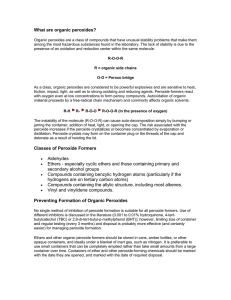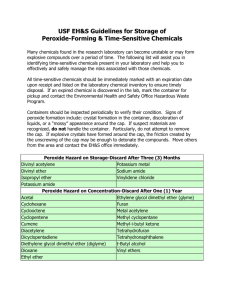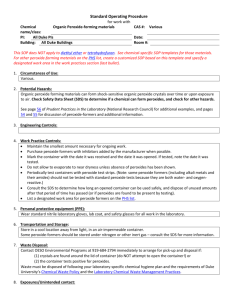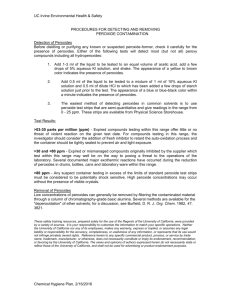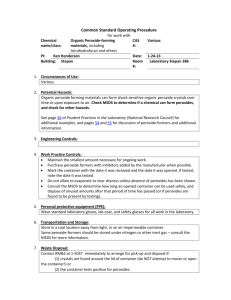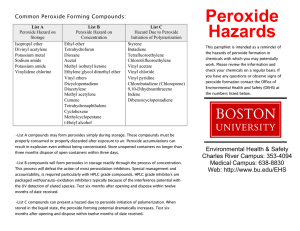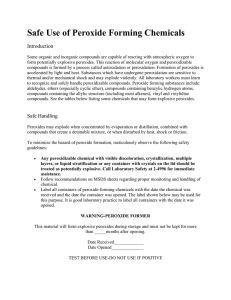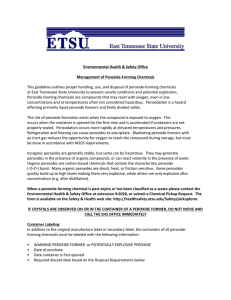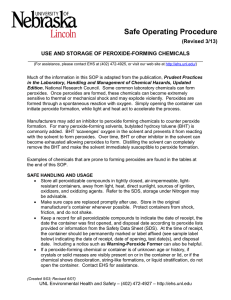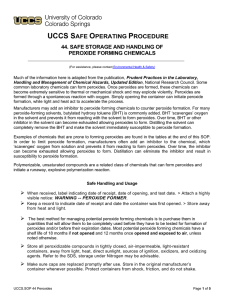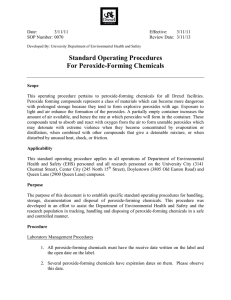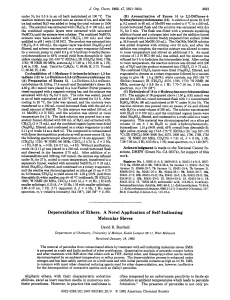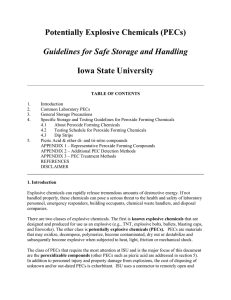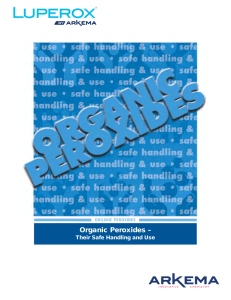1. Any expired or out of date chemical must... risk within the laboratory. Contact EH&S for help in determining... COEN Safety Committee Expired Chemical Policy
advertisement
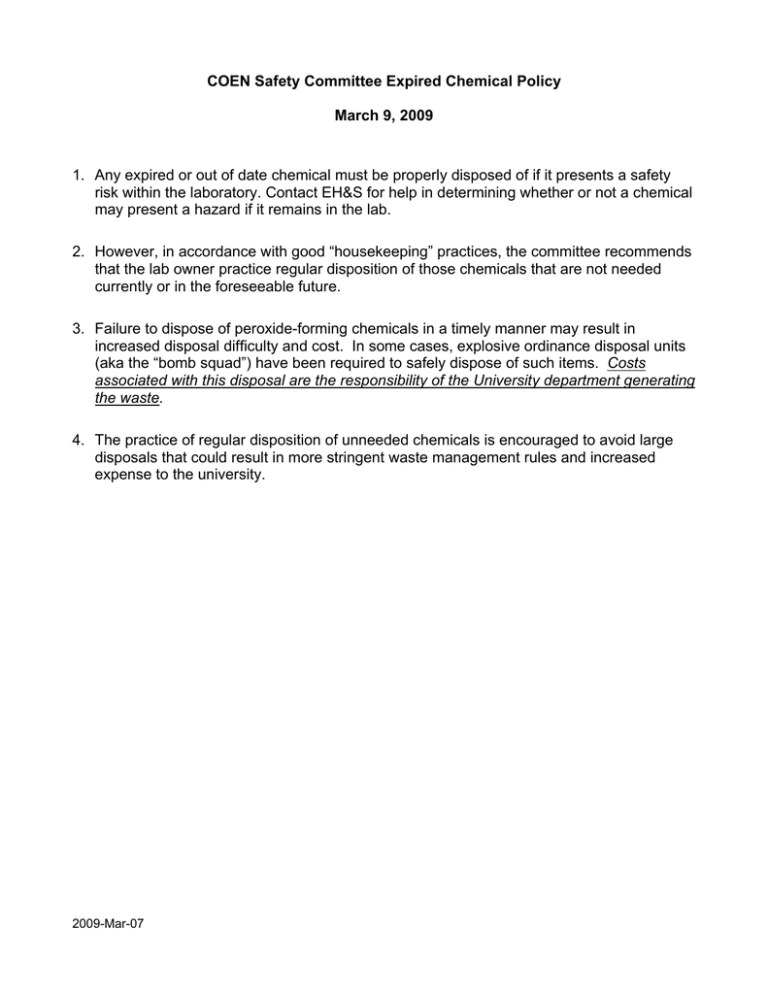
COEN Safety Committee Expired Chemical Policy March 9, 2009 1. Any expired or out of date chemical must be properly disposed of if it presents a safety risk within the laboratory. Contact EH&S for help in determining whether or not a chemical may present a hazard if it remains in the lab. 2. However, in accordance with good “housekeeping” practices, the committee recommends that the lab owner practice regular disposition of those chemicals that are not needed currently or in the foreseeable future. 3. Failure to dispose of peroxide-forming chemicals in a timely manner may result in increased disposal difficulty and cost. In some cases, explosive ordinance disposal units (aka the “bomb squad”) have been required to safely dispose of such items. Costs associated with this disposal are the responsibility of the University department generating the waste. 4. The practice of regular disposition of unneeded chemicals is encouraged to avoid large disposals that could result in more stringent waste management rules and increased expense to the university. 2009-Mar-07 Appendix A-1. Peroxide Forming Compounds COMMON COMPOUNDS THAT FORM PEROXIDES DURING STORAGE The most hazardous compounds - those that form peroxides that may explode even without being concentrated - are in List A. Compounds forming peroxides that are hazardous only on concentration, such as distillation or evaporation, are in List B. List C is made up of vinyl monomers that may form peroxides that can initiate explosive polymerization of the bulk monomers. Each list contains the recommended storage period in parenthesis. List A - (Three Months) - Peroxide Hazard on Storage • • • • • Divinyl acetylene Isopropyl ether Potassium metal Sodium amide Vinylidene chloride List B - (Twelve Months) - Peroxide Hazard on Concentration • • • • • • • • • • • • • • Acetal Cumene Cyclohexene Diacetylene Dicyclopentadiene t-butylalcohol Dioxane Ethylene glycol dimethyl ether (glyme) Ethyl ether Methyl acetylene Methylcyclopentane Methyl i-butyl ketone Tetrahydrofuran Tetrahydronophthalene Vinyl ethers List C - (Twelve Months) - Hazard Due to Peroxide Initiation of Polymerization* • • • • • • • • • • Acrylonitrile Butadiene Chlorobutadiene (Chloroprene) Chlorotrifluoroethylene Dibenzocyclopentadiene 9,10 Dihydroanthracene Indene Styrene Tetrafluoroethylene Vinyl acetate 2009-Mar-07 • • • Vinyl acetylene Vinyl chloride Vinyl pyridine * When stored as a liquid, the peroxide-forming potential increases and certain of these monomers (especially butadiene ) chloroprene and tetrafluoroethylene) should then be considered as List A compounds. ADDITIONAL PEROXIDE FORMERS • • • • • • • • • Bis (2-chloroisopropyl) ether Bis (2-ethoxyethyl) ether Butyl-lithium Cyclopentadiene Ethylene Glycol Dimethyl Ether Methyl Isobutyl Ketone Methyl Lithium Phenyl Lithium Tetrafluoroethylene Additional Information on Peroxide Formers How old is suspect materials? Try to determine when material was purchased. The longer a chemical is stored, the greater chance it has to form peroxides. Check storage conditions Stored in sunlight - good promoter of peroxidation. Stored in heated area (e.g. above room temperature) - good promoter of peroxidation. Shape of container - Are they dented, in bad shape? - Could lead to peroxidation. Are containers free from contamination? - Contamination by metals or metal oxides can help promote peroxidation. Have containers been opened? - Containers that have been opened are more of a threat to form peroxide. Is cap on container secure? - Unsecured cap can cause air to be let into container, could lead to peroxide formation. If compound is suspect, do not open, friction can cause enough shock to detonate the material. Visual inspection of containers. Increased or unusual viscosity. 2009-Mar-07 Color changes. Pale or brown crystal formation around rims or caps. Do not shake bottles or cans upon inspection. If any of the above problems are identified upon inspection, do not touch material, contact the Environmental Health and Safety Office for assistance. SAFEGUARDS FOR STORING POTENTIAL PEROXIDE FORMERS 1) Store in cool area. 2) Store away from direct sunlight. 3) Purchase materials only as needed. 4) Protect containers from physical damage. 5) Monitor with the use of log. • • • Purchase date Opening date Open only when needed, eliminate unnecessary opening. Do not expose to air unnecessarily. 6) Keep container tightly closed or stoppered. 2009-Mar-07 Appendix A-2. Peroxide Forming Compounds 2009-Mar-07

